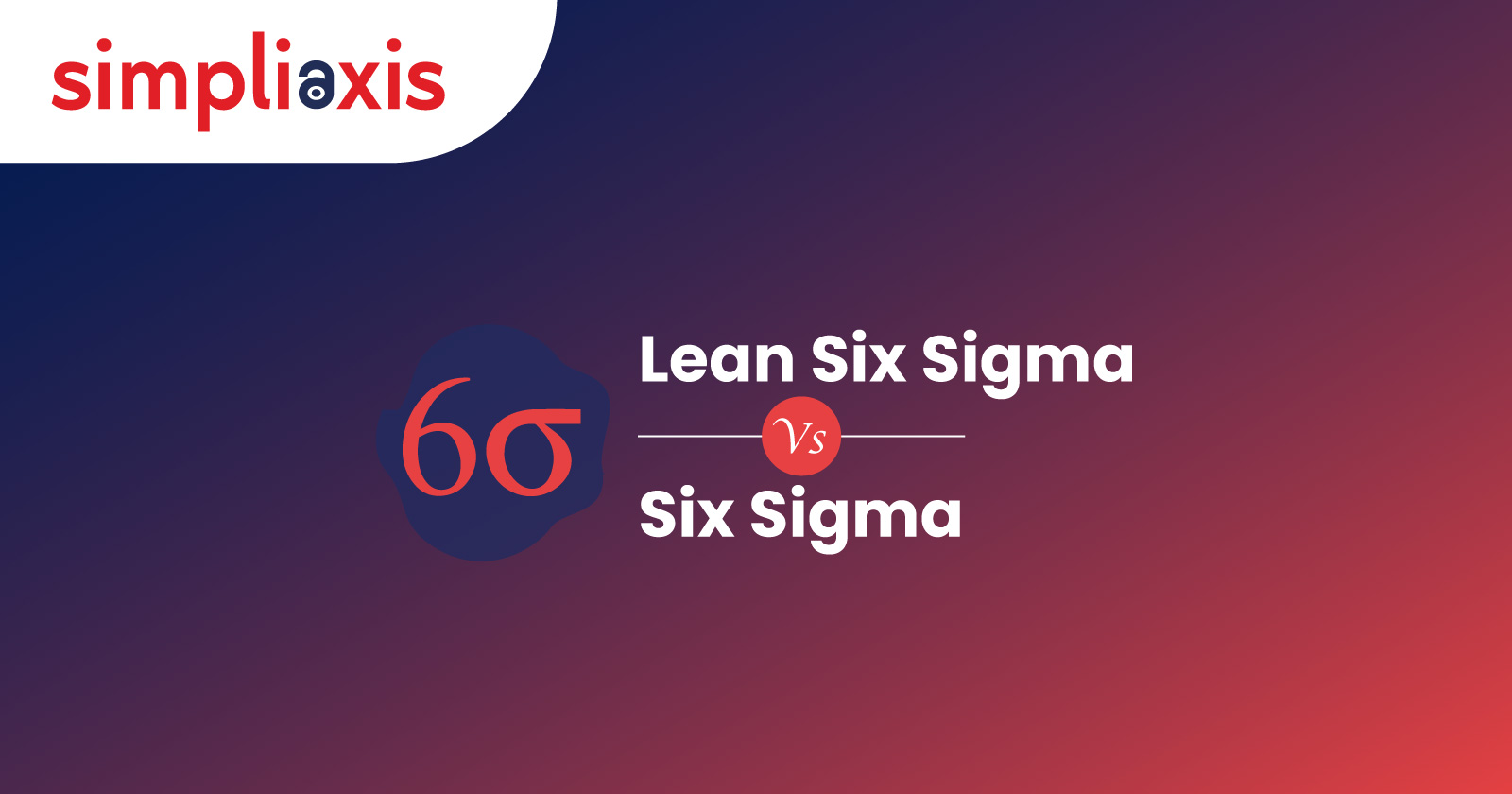Introduction :-
Organizations have used many proven tools and techniques to enhance productivity, efficiency, and performance. They know how these tools and techniques help them achieve organizational goals. However, with the passage of time, even the most proven approach has to adapt to the changed market conditions and the way of doing business. Six Sigma is also not untouched by this phenomenon. The original concept, introduced years ago, has changed considerably with the emergence of new disciplines and schools of thought to match the current scenario and requirements. The same thing applies to Lean also. Over the past years, these two business strategies have proved that by improving the performance of different in-house processes and/or modernizing them, notable improvement can be achieved in cost efficiency and quality.
There is always a discussion going on in the business world about which is the better system for streamlining the processes and curbing waste, Lean or Six Sigma? Some argue in favor of Lean, while others bat for Six Sigma. All of them can give reasons for favoring one or the other. They can give examples of situations where either Lean or Six Sigma would provide a better result. Some others say that the best way of building the most efficient and effective business structure is to combine both, Lean and Six Sigma. In this case, two different schools of thought would merge into a cohesive approach that would be able to provide solutions for multiple goals. Several companies have already started using this combination, which is called Lean Six Sigma. Lean Six Sigma and Six Sigma strive to achieve more effective processes that would yield bigger bottom lines. The difference is in the approach they take to achieve these objectives. However, before understanding the merits or demerits of the two approaches, let us first understand Six Sigma and Lean individually.
What is Six Sigma?
A data-driven and disciplined Six Sigma methodology, aims to eliminate defects in any type of process, be it manufacturing, transactional, or service. So, Six Sigma essentially removes the deficiencies in processes and reduces waste. When Six Sigma was introduced, it had a specific goal: to use statistical analysis to reduce variations and rates of defects in production processes. And to achieve those objectives, either of the two 5-step methods is used. They are Define, Measure, Analyze, Improve, and Control (DMAIC) and Define, Measure, Analyze, Design, and Verify (DMADV). In the DMAIC process, you first identify the problem to be solved, then evaluate your existing processes, find a solution and implement it, and maintain that solution all the time. This process is ideal when you are required to make only adjustments to the process and don't need to create an entirely new function. In the DMADV process, the initial phases are the same. It is the design part where the difference occurs. The design part lets you create a new tool for solving the problem. And in the Verify phase, the focus is on ensuring that the new solution continues to solve the problem. As we mentioned earlier, Six Sigma was initially introduced with the aim of monitoring the production or manufacturing processes. Still, those using it later found that it could be useful for and could be applied to almost all aspects of the business. So, as a result, today Six Sigma plays a vital role in the leadership of any organization. When applied on a wide scale, companies can get actual results that can be measured.
What is Lean?
The focus of Lean is totally on removing waste. The aim is to provide maximum value to customers at the minimum possible investment. Therefore, Lean is said to create more value with fewer resources and even less waste. And Lean is also a practice where continuous experimentation takes place to achieve excellent value with nil waste. The Toyota company first used the term "lean" in the 80s to define the Toyota Business System, which was their business philosophy that helped the company run efficiently. Every level of the organization is involved in the process of guiding new processes and allocation of resources.
Lean emphasizes removing those steps in the process that are not necessary and retaining only those steps that directly add value to the product. But how to find out if something is adding value or not? As per the Lean methodology, the only way to find this out is to see if the customer wants to pay for it. So, suppose anything or steps do not add value to the product. In that case, it is removed from the process, leaving the organization with a streamlined process that would be profitable. It would be an efficient process where the work would move smoothly. So, while Six Sigma is primarily used for manufacturing processes, Lean helps in every aspect of the business. So, a lean enterprise is organized in such a way as to continuously understand the customers and their context, which would help in setting down the value to be provided and keep looking for better ways of delivering it.
You would like to ask what the difference is between Lean Six Sigma and Six Sigma and how they measure against each other. Or you may ask which one of these is more beneficial. We are going to answer these questions below. Having learned about Six Sigma and Lean separately, let us now understand what the difference is between Lean and Six Sigma.
Lean vs Six Sigma
There is a continuous debate about the difference between Lean and Six Sigma, and the moot point is whether they are mutually exclusive. There is a difference between the two at the very basic level. The difference comes up at the goal level itself. While the main objective of Lean is to reduce waste, Six Sigma aims to reduce process variations and enhance process capability. Another way of looking at Six Sigma is as a business strategy or a philosophy that helps organizations to reduce defects in all of their processes, meaning both industrial and commercial processes, and stay ahead of the competition. However, both Lean and Six Sigma are improvement strategies. Lean helps in reducing waste, while Six Sigma helps reduce process variations.
Another difference between Lean and Six Sigma is in the training. While Lean requires little or no training, Six Sigma requires formal training and dedicated infrastructure. Six Sigma training provides different levels of expertise in the form of 'Belts' like Black Belts. There is a difference in their application, too. Lean is normally applied in manufacturing processes. Six Sigma, on the other hand, can be applied to any type of business process.
Another major difference between Lean and Six Sigma is that Six Sigma does not try to change the culture in an organization while Lean attempts to restructure the organizational culture and employee behavior. There is a difference between how these two are driven too. A Six Sigma project is driven by data while Lean is driven by demand. Also, Six Sigma projects are more complex while Lean projects are relatively simpler.
Now, the question arises: Can Lean and Six Sigma coexist? Let us first understand Lean Six Sigma.
What is Lean Six Sigma?
Business processes keep evolving all the time to keep up with ever-advancing technology and changing market demands. And Six Sigma is also not untouched by that. So, it was combined with the Lean methodology to create an approach focusing on both process speed and efficiency. This is what Lean Six Sigma is. It is a philosophy for improvement based on facts and driven by data that puts more emphasis on preventing defects rather than detecting defects. It is a managerial approach for improving processes by eliminating waste of resources and defects.
The combination of Six Sigma methods and Lean philosophy strives to remove the wastage of physical resources like man, machine, and material along with other critical components of the process like time and effort and assure quality in manufacturing and organizational processes. Lean Six Sigma helps reduce process variations, wastes, and cycle time and encourages standardization of work and its flow, thus enhancing customer satisfaction and bottom-line results, which, in turn, provide a competitive edge. Around the world, Lean Six Sigma's team-oriented method has proved beneficial in maximizing efficiency and greatly improving the profitability of organizations. In simple words, Lean Six Sigma tells us that if we use resources that do not create any value for the customer or end-user, we are just wasting those resources.
Coming back to the question of whether Lean and Six Sigma can coexist in an organization, the answer is 'yes.' Lean methods can be applied before and can work along with Six Sigma methods. Organizations' major issues are a lot of waste, minimizing inventories and improving workflows, speeding up processes, and reducing human errors. So, Lean can be used to speed up processes and simplify them, improving workflows and reducing inventories. However, if there are other issues mentioned above, like quality, abnormal variations, challenges in identifying root causes, etc., thenSix Sigma tools can be used to tackle these issues. A combination of these problems usually exists in organizations, so the self-evident approach here is using Lean and Six Sigma in tandem.
More and more organizations are adopting this combination of Lean and Six Sigma and merging their efforts into Lean Six Sigma. Industries like manufacturing, healthcare, service, defense, insurance, etc. are increasingly using Lean Six Sigma to get solutions for the various issues related to their processes. How Lean and Six Sigma work together varies. But the best results are achieved when the management is involved, the organization has a team of well-trained professionals, team members are trained properly and the team is used well, and with the proper application of the tools.
Conclusion:
Lean Six Sigma and Six Sigma are both powerful methodologies for improving organizational processes, but they differ in focus. Six Sigma aims to reduce process variations and defects through a structured, data-driven approach, while Lean focuses on eliminating waste and enhancing efficiency. Lean Six Sigma combines these strengths, offering a comprehensive strategy for process improvement. This synergy maximizes efficiency, reduces waste, and ensures high-quality outputs. Many organizations benefit from integrating both methodologies, as Lean Six Sigma addresses a broad range of process-related challenges. Simpliaxis offers six sigma courses to help you master these methodologies and enhance your project management skills.



















